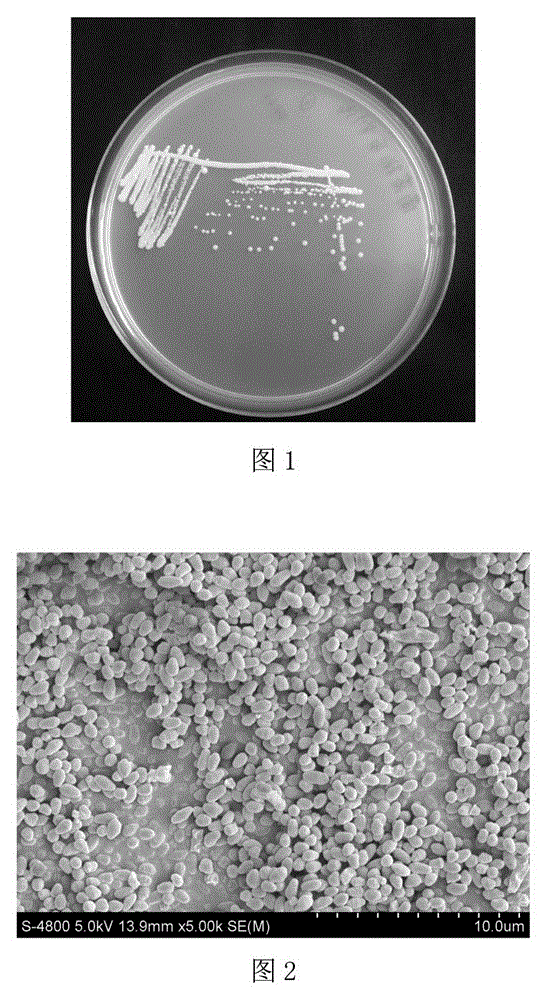Polycyclic aromatic hydrocarbon removal composite material, and preparation method and use thereof
A technology of polycyclic aromatic hydrocarbons and composite materials, applied in the field of microbial engineering, can solve the problems of low abundance of functional microorganisms, difficulty in survival or short survival time, and influence on the removal effect of PAHs, and achieve good tolerance
- Summary
- Abstract
- Description
- Claims
- Application Information
AI Technical Summary
Problems solved by technology
Method used
Image
Examples
Embodiment 1
[0064] Example 1: Screening and isolation of bacterial strains
[0065] Enrichment culture: Take PAH-contaminated soil of Beijing Coking Plant as the bacterial source, weigh 10g of soil, add 90ml of sterile water and 0.5g of glass beads, shake in a shaker at 180r / min, 30°C for 3h, and let it stand for 30min 5ml of the supernatant was inoculated into 45ml of sterilized MSM culture solution containing 50mg / L pyrene, cultured on a shaker at 30°C and 180r / min. Every 10 days, 5ml culture solution was transferred to 45ml pyrene concentration gradient to 100, 200, 300, 500mg / L fresh sterilized MSM culture solution, and the enrichment of PAH-degrading bacteria was completed after 5 transfers.
[0066] Screening of bacterial strains: Take a certain amount of the last enrichment culture solution and spread it on the MSM solid plate, turn the plate upside down in a beaker containing pyrene, and spread a layer of pyrene film on the MSM solid plate by sublimation method. The plate coated ...
Embodiment 2
[0073] Example 2: Substrate broad-spectrum test for the degradation of polycyclic aromatic hydrocarbons by bacterial strains
[0074] Add naphthalene, acenaphthene, dihydroacenaphthene, fluorene, phenanthrene, anthracene, fluoranthene, pyrene, and benzopyrene to a 100ml Erlenmeyer flask containing sterilized MSM culture solution, so that the contents of the above nine polycyclic aromatic hydrocarbons are all 50 mg / L, inoculate 0D with 10% inoculum 600 =1.0 Mycobacterium gilvum Bacterial liquid (gained in embodiment 1, hereinafter all the same). All the flasks were placed in a shaker at 30°C and 180r / min for shaking culture, and samples were taken on the 0th, 4th, and 8th days to determine the residual amounts of polycyclic aromatic hydrocarbons in the flasks. The experimental results show that the strains cannot degrade acenaphthene, dihydroacenaphthene, and benzopyrene in the above-mentioned polycyclic aromatic hydrocarbons. The degradation results of the other six kinds o...
Embodiment 3
[0079] Embodiment 3: Degradation test of bacterial strain to pyrene
[0080] Add a certain amount of pyrene (dissolved in acetone) into a 100ml Erlenmeyer flask containing sterilized MSM culture solution, and add MSM culture solution after the acetone has volatilized, so that the initial content of pyrene is 50mg / L. Inoculate 0D at 10% inoculum size 600 =1.0 Mycobacterium gilvum bacteria liquid. The flask was placed at 30°C and cultured in a shaker at 180r / min, and destructive sampling was carried out on days 0, 1, 2, 3, 4, 5, 6, 7, 8, 9, and 10 to determine the residual pyrene in the flask. quantity. see results Figure 5 ,from Figure 5 It can be seen that the degradation rate of pyrene at an initial concentration of 50 mg / L by the strain can reach 57.85% on the 4th day, and can reach 96.76% on the 9th day.
PUM
| Property | Measurement | Unit |
|---|---|---|
| Particle size | aaaaa | aaaaa |
| Particle size | aaaaa | aaaaa |
| Particle size | aaaaa | aaaaa |
Abstract
Description
Claims
Application Information
 Login to View More
Login to View More - R&D
- Intellectual Property
- Life Sciences
- Materials
- Tech Scout
- Unparalleled Data Quality
- Higher Quality Content
- 60% Fewer Hallucinations
Browse by: Latest US Patents, China's latest patents, Technical Efficacy Thesaurus, Application Domain, Technology Topic, Popular Technical Reports.
© 2025 PatSnap. All rights reserved.Legal|Privacy policy|Modern Slavery Act Transparency Statement|Sitemap|About US| Contact US: help@patsnap.com



